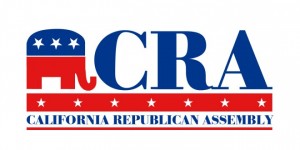Updated material follows. The “nuclear option” went live today here is an analysis.
The nuclear option reads as follows:
It is the policy of CRA that Convention Delegates and Alternates must reside in the geographical boundaries of their respective chartered Republican Assemblies. In order to prevent massive voter fraud, this policy will be implemented immediately and communicated to unit presidents, Board members, and proposed Delegates and Alternates as soon as possible. The CRA Board of Directors requests that the Convention Rules Committee and the Credentials Committee adopt fair and even-handed policies and rules to implement this Board policy. In order for the Credentials Committee to identify and communicate with Delegates and Alternates who may reside outside the boundaries of their respective chartered Republican Assemblies, four new members are hereby appointed to that Committee to help implement that effort…
Oh, the vote is due 03-31-11
Per President Celeste Greig, please vote (YES, NO, ABSTAIN), no later than the end of Thursday, March 31, 2011, on the motion below concerning the upcoming CRA Convention.
Two sections of the CRA Bylaws have a direct bearing on this proposal. They read as follows:
ARTICLE IX
BOARD OF DIRECTORS
Section 9.04. Special Meetings. The Board of Directors may, without meeting together, transact business by mail, by voting on questions submitted to them by or with the approval of the President. Fifteen days shall be allowed for the return of the votes by mail, facsimile, or electronic mail to the Corresponding Secretary. The voting shall be considered closed at the end of fifteen days, provided that the majority of the members of the Board shall have returned their votes by that time, or it shall be considered closed at any time prior thereto if and when all of the Directors have returned their votes. If, at the expiration of the fifteen-day period, a majority of the Board of Directors has not returned their votes, the measure being voted upon shall be deemed to have failed. The Secretary must preserve all ballots received until the next meeting of the Board of Directors, at which meeting the Board of Directors shall order the disposition of the ballots. In cases where a hearing is required by the Bylaws of the CRA, voting by mail shall not be permitted unless authorized by a two-thirds vote of all members of the Board of Directors.
Clearly a two day voting window is a violation of the State Bylaws.
ARTICLE IV
MEMBERSHIP
Section 4.04. Membership Requirements. In order to be eligible to join CRA, a person must be an American citizen of good moral character who is registered to vote as a Republican in the State of California.
Thus anyone can join any Republican Assembly as long as they reside in the State of California and are a registered Republican. If you can live anywhere and be a member, it is only logical that you could be a delegate too.
My daughter is in college in Southern California and a member of our Sacramento County unit. If a convention was held in Orange County and due to the cost of travel, it was necessary for her to be a delegate I would have no problem with that. It would allow our unit to be better represented by someone that we know and at a cost savings to members of our unit. Sure the folks attending the meeting locally should be offered the delegate positions first but if we need her and it works with her schedule then why not call on her?
However, such a generous membership policy was not always the case. I have a copy of the 1991 CRA Bylaws because I was at the Spring Convention and had several resolutions adopted that my friend Donna and I wrote. As a result, I kept my newsletter from the event as a souvenir. If you can find a copy, look at the following section:
ARTICLE XII
REPUBLICAN ASSEMBLIES
Section12.03. Qualifications for Membership. Members of each Chartered Republican Assembly shall be those American citizens of good moral character who are registered with the Republican Party, in the geographical area of that Chartered Republican Assembly, except that those registered in an area where there is no Chartered Republican Assembly may become members of a Republican Assembly in a nearby unit until a new Republican Assembly may be Chartered Republican Assembly and must continue to comply with those Bylaws, and must pay such annual dues as may be fixed.
Because of other adventures that I had in the CRA, I know that this was changed sometime after 1999, when the requirements to live within the boundaries of the chartered club were dropped and residence anywhere in the State was instead adopted.
When I get into the tall grass with issues like this, I often hearken back to the Tom Cruise movie The Firm. The challenge of his character was how to get out of the mess he was in without tarnishing himself and losing his ability to practice law. He decided that if he would follow the law that he would be on safe ground and he could find a legitimate way of punishing the bad guys. In short should you cheat or behave honorably?
I think supporters of both Celeste Greig and Karen England should follow the rules and may the best person win. The irony of all this is that a Bylaws amendment has been written to deal with the delegate issue and it is likely to pass at the upcoming convention. After this gathering it should be a mute point.
Celeste has had two years to decertify the charters of the “paper clubs” that she now fears. She also could have set some delegate guidelines at the January 2011 Board Meeting but she lacked the foresight to do that. If she and her team failed to move on these issues when they had the time to do so then that’s too bad. The die is cast and to try to change the rules after the delegate deadline is destructive to the organization and says that the actual character of Celeste and her public persona are greatly divergent. Trying to suspend the Constitution to save the Union only worked for Lincoln because he had a bigger army.





